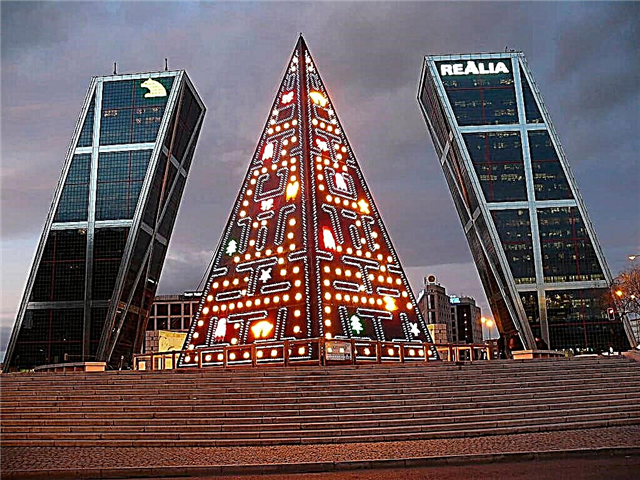Madrid is one of the most beautiful cities in the world, there are many parks and boulevards, ancient monuments, grandiose cathedrals and majestic palaces. It is not only history that attracts numerous tourists to the capital of Spain - the unique objects of modern urban planning also surprise and delight. For example, the symmetrical sloping structures built in Madrid at the end of the last century, called the "Gateway to Europe", quickly became a tourist attraction.
Construction history
The falling twin towers that appeared in the capital are not an oversight of the builders, as sometimes happens, the skyscrapers were built according to a well-calculated and complex project. Their creators are American engineers - John Burgey and Philip Johnson. Talented and creative young people wanted to do without right angles and typical designs, to create something unusual and original.
American architects presented their project for approval, it was approved, and in the main city of Spain began the construction of a unique structure. The foundation was laid in December 1989, the construction of both buildings was completed in September 1994 at the same time, since work on the two objects was carried out in parallel.
The grand opening took place in 1996. At the year of completion, the buildings were the second largest in Spain (the tallest were in the Canary Islands). They have given Madrid its charm, creating an amazing contrast between modern buildings and the many ancient palaces and monuments.
Architectural and design features

Not everyone knows that these are the only inclined skyscrapers in the world not today. The Spaniards are very proud of this miracle of architecture. The falling structures are tilted to each other by 15 degrees, each building is 26 stories high. The top of the towers, with a total height of 115 meters, extends beyond the base by 30 meters, which is half the width of the building. If we compare them with the famous Leaning Tower of Pisa, then they have a greater inclination and are three times higher.
This is clearly visible if you follow the glance behind the decorative plates on the facade. The diagonal of the side face is in a vertical position, it connects the pivot point to the opposite corner at the top of the building. The buildings were built using a new technique of erecting inclined structures in relation to the vertical axis of the structures. In practice, this method was called “a la Leaning Tower of Pisa”.
Huge concrete counterweights, equipped in the basement, keep buildings from collapsing and falling, powerful steel beams act as frames and give stability. A new original solution - beams run along the outer part of the facade, encircling it around the perimeter. The architecture of the complex has not been repeated to this day.
The exterior design is composed of vertical and horizontal metal sheathed sections. An important role in the design of the external appearance is played by the color of the facade material - white steel, thin bright red metal lines and dark gray glass. Few people know how the problem of lifting people to the upper floors, of which there are 26 in each building, has been solved - one elevator goes to the 13th floor, passengers change from the 14th floor to another.

Between the buildings there is a monument made by famous Spanish architects Carlos Ferreira and Manuel Manzano Moniza. The monument is dedicated to the politician and lawyer Jose Carlos Sotelo. The assassination of General Sotelo in 1936 is believed to have sparked a bloody civil war. The monument, made of white marble, creates a single ensemble with twin towers. Installed in 1960. In 1996, unique buildings were awarded the Outstanding Findings in the Construction Industry.
Purpose

Located in the northern part of the city, they symbolically indicated the entrance to the city, although over the past two decades the capital has expanded beyond their borders. The bright and spacious interiors are home to numerous offices from various companies. The place is popular - the “Gateway to Europe” has become a part of the life of the capital. It especially fell in love with artists, who several times a year arrange interesting installations, vernissages, and colorful performances on the site.
The directors are not lagging behind, even before the completion of the construction they shot the “black” comedy “Day of the Beast” and other feature and documentary films. In December, the main Christmas tree of Spain is decorated here, around which many adults and children always come on the most revered Catholic holiday. The left tower (as viewed from the center of Madrid) is called the Door to Europe 1, the opposite is the Door to Europe 2.

There are helipads on the roof. They were painted in different colors (blue red) so that the pilots did not make mistakes when landing.
A little about the owners of the "twins"
The facilities were originally owned by the Kuwait Investments Office (KIO), which has invested tens of millions of euros in the construction. By the abbreviation of the company, they began to be called simply “KIO Towers”.
Subsequently, the Kuwait Investments Office sold the building to the Spanish bank Caja Madrid and the Realia real estate agency. This is evidenced by the logos on the facades of the upper floors of both buildings. Since then, the name has changed to a more poetic one - "Gateway to Europe".
At the center of a financial scandal
During the construction, a criminal investigation was involved. The construction of the falling skyscrapers required significant financial investments, which amounted to millions of euros. The funds were allocated by the KIO company counting on the engineering assistance of Spanish specialists.
Huge money went through the company financier Javier De La Rosa. Obviously, the man could not resist the temptation and appropriated part of the funds allocated for the construction. Rosa was accused of embezzlement of 375 million euros, a criminal case was opened. The money belonged to the Kuwait Investments Office and its Spanish subsidiary, Group Torres. The top manager was sentenced to 19 years (according to other sources - 14).
An interesting touch in this high-profile scandal - the financier promised to destroy the towers after being released from prison. I wonder if he will be able to carry out the terrible threat? In addition to Rosa, other actors were under investigation who became participants in multimillion-dollar frauds - Manuel Prado and Colon Carvajal, they were also punished according to the law.
Where are they and how to get there

Puerta de Europa is located in the center of Madrid in the Plaza de Castilia on the Paseo de la Castellana boulevard, Madrid, Spain.
How to get there:
- For sightseeing, it is convenient to take the metro - stop Plaza de Castilia (Plaza de Castile).
- you can use the bus, routes No. 5, 7, 42, 49, 70, 124, 129, 147, 174. Stop Plaza de Castilia (Plaza de Castile).
Madrid is the most beautiful European city. Here you can walk for days along the old narrow streets or boulevards lined with ultra-modern buildings. There are many interesting and unique things in the capital, including the world's only falling skyscrapers.
We recommend the following hotels in Madrid:











